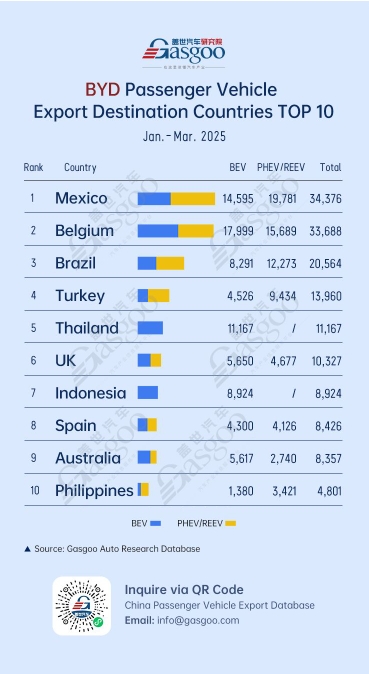
BYD’s top 10 export markets for passenger vehicles in Q1 2025 include Mexico, with 34,376 units (14,595 BEVs and 19,781 PHEVs); Belgium, with 33,688 units (17,999 BEVs and 15,689 PHEVs); Brazil, with 20,564 units (8,291 BEVs and 12,273 PHEVs); Turkey, with 13,960 units (4,526 BEVs and 9,434 PHEVs); Thailand, with 11,167 BEVs; the UK, with 10,327 units (5,650 BEVs and 4,677 PHEVs); Indonesia, with 8,924 BEVs; Spain, with 8,426 units (4,300 BEVs and 4,126 PHEVs); Australia, with 8,357 units (5,617 BEVs and 2,740 PHEVs); and the Philippines, with 4,801 units (1,380 BEVs and 3,421 PHEVs).
The data highlights three market types: PHEV-dominant, balanced, and BEV-focused. In PHEV-dominant markets like Mexico, Brazil, and Turkey, limited charging infrastructure and consumer concerns about range drive demand for PHEVs. Brazil’s ethanol fuel policies further enhance PHEV appeal due to biofuel compatibility. A Gasgoo researcher noted: “These categories not only reflect varying infrastructure and policy landscapes, but also showcase BYD’s targeted market strategy.”
In balanced markets such as Belgium, the UK, and Spain, diverse consumer preferences and supportive policies foster both PHEV and BEV adoption. In April 2025, Spain extended its “Moves III” program with a €400 million budget to support EV purchases and charging infrastructure, boosting electrification.
BEV-focused markets like Thailand and Indonesia benefit from low import tariffs on NEVs. Thailand’s “EV 3.5” program, reducing consumption tax on imported NEVs priced below 7 million baht from 8% to 2% through 2025, has encouraged Chinese automakers, including BYD, to expand in Southeast Asia.
BYD’s “dual-engine” strategy, promoting both PHEVs and BEVs, addresses diverse market needs. In emerging markets, PHEVs bridge infrastructure gaps, while in mature European markets, policies support varied technologies. In Southeast Asia, BYD leverages incentives to strengthen its BEV presence, positioning it to meet global demand and adapt to competitive EV markets.